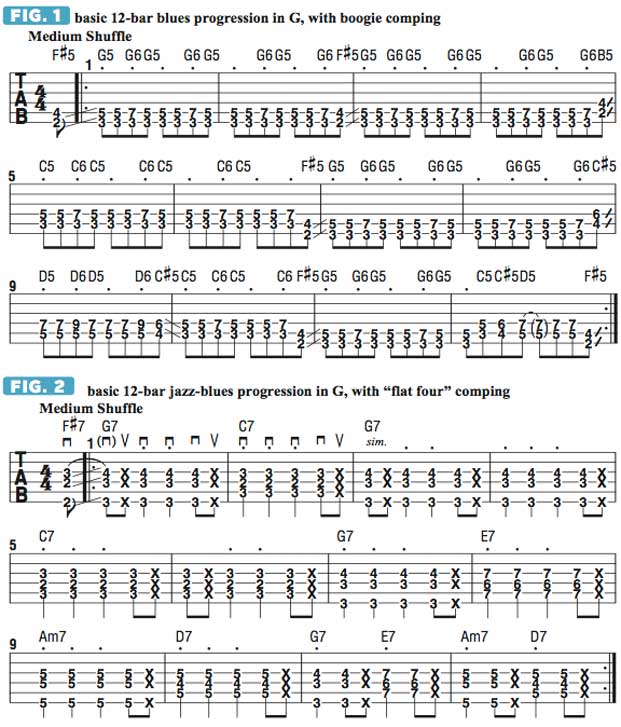A Guide to Basic Jazz-Blues Changes
Presenting a more musically sophisticated variation on the standard 12-bar blues.

In this lesson I’d like to introduce, for those who aren’t already acquainted with it, the basic jazz-blues chord progression in the guitar-friendly key of G.
It’s a more musically sophisticated variation on the standard 12-bar blues, one that jazz players almost universally prefer to solo over and use as a basis for improvising harmonically rich melodies and adding colorful chord substitutions. There are two fundamental differences between a standard blues and a jazz-blues progression.
The first difference is the accompaniment, or “comping,” style, and the second is the type of chords used. In pure blues, guitarists will often play a Chuck Berry–style “boogie” pattern using root-fifth power chords, the fifth alternating with the sixth to add melodic interest and create a feeling of forward motion, as demonstrated in FIGURE 1.
This progression is known as basic one-four-five blues changes, with G being the one chord, C being the four and D being the five. A common variation, used more often at slower tempos, is to add what’s called the “quick change to the four” in bar 2. In this case, you would go to C5 then back to G5 in bar 3. (Use the same one-fret slide-ups as in bars 4 and 6.) Jazz guitarists, when comping on a blues progression, use different types of chords; instead of power chords, they’ll play voicings that include both the third and the seventh, which are the notes that define a seventh chord’s quality, such as dominant seven, major seven or minor seven, and omit the fifth, which is unnecessary in that regard, unless it’s a flat-five or sharp-five.
They’ll sometimes also omit the root note and rely on the bassist to play it, for the sake of not having any redundant notes in the overall sound. But when comping without a bass player, such as in a two-guitar jam, they’ll usually include the root on the bottom of each seventh-chord voicing, as illustrated in FIGURE 2. These chords are examples of what jazz arrangers call shell voicings, which include only the notes necessary to define a chord, and no octave doubling either, as you would have in a full barre chord.
Guitarists refer to them as “muted-string chords” because unused adjacent strings are muted with the fret hand in order to prevent any unwanted open notes from sounding. Fret the G7 shape in FIGURE 2 with your first, second and fourth fingers. The strum pattern here is what’s known as a big-band-style flat-four feel, comprising mostly down-strummed quarter notes, with an occasional muted-string upstoke “hiccup” added on an eighth-note upbeat—on one of the “and” counts—to convey a shuffle, or swing, feel.
To perform these muted-string strums (indicated by X’s in the tablature), simply relax your grip on the previous chord shape, but without letting go of the strings, and strum. The other fundamental difference between a blues and a jazz-blues progression is that, in bars 9 and 10 of a jazz-blues, instead of going to the five chord and then the four, as we do in FIGURE 1 (D to C), we have what’s called a two-five, the two chord being a minor seven, Am7 in this case (see bars 9 and 10 of FIGURE 2).
This Am7 voicing is best fretted with the ring finger barring the D and G strings. Additionally, the “six” chord, E7, is substituted for G7 in bar 8 for the sake of creating a strong musical push toward Am7. This “push chord” is called the five of two. The same chord change happens again in bars 11 and 12, here as part of what’s called a one-six-two-five turnaround, which is identical to bars 7–10, but played in a doubled-up harmonic rhythm.

Get The Pick Newsletter
All the latest guitar news, interviews, lessons, reviews, deals and more, direct to your inbox!
Over the past 30 years, Jimmy Brown has built a reputation as one of the world's finest music educators, through his work as a transcriber and Senior Music Editor for Guitar World magazine and Lessons Editor for its sister publication, Guitar Player. In addition to these roles, Jimmy is also a busy working musician, performing regularly in the greater New York City area. Jimmy earned a Bachelor of Music degree in Jazz Studies and Performance and Music Management from William Paterson University in 1989. He is also an experienced private guitar teacher and an accomplished writer.
“There are so many sounds to be discovered when you get away from using a pick”: Jared James Nichols shows you how to add “snap, crackle and pop” to your playing with banjo rolls and string snaps
Don't let chord inversions bamboozle you. It's simply the case of shuffling the notes around








![Joe Bonamassa [left] wears a deep blue suit and polka-dotted shirt and plays his green refin Strat; the late Irish blues legend Rory Gallagher [right] screams and inflicts some punishment on his heavily worn number one Stratocaster.](https://cdn.mos.cms.futurecdn.net/cw28h7UBcTVfTLs7p7eiLe.jpg)


